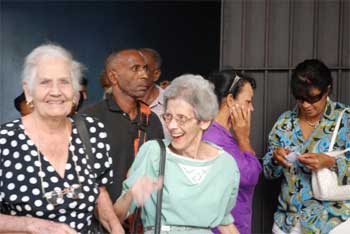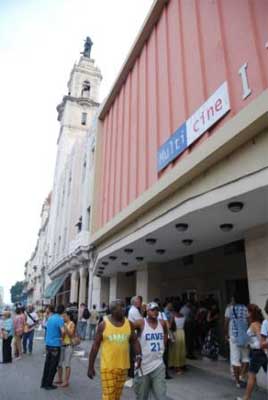Havana’s Movie Theater Dilemma
Yusimi Rodriguez

HAVANA TIMES, April 17 – In Cuba, in contrast to other countries, the movies aren’t a luxury but a form of entertainment that’s accessible to people of all incomes. A ticket costs two pesos in national currency (US 10 cents).
In the opinion of a Swiss friend, it’s not all that cheap though, if you consider it in relation to many salaries or retirement pensions (under 15 usd), but up until now we’ve all been able to afford it.
The majority of the spectators who I see in the theater are retired people – older people who recall with nostalgia the movies of Errol Flynn, Elizabeth Taylor, and Humphrey Bogart that they saw in their youth. Back then it was three or four movies for only 10 centavos of a Cuban peso.
Sometimes, they wouldn’t leave the theater until dark. Inside, popcorn, potato chips, sandwiches and even cold drinks were sold. The moviegoers didn’t even have to get up, as the vendors would bring their varied offerings right to the seats.
Today, ten centavos won’t even get you onto a bus, and the neighborhood movie theaters have been slowly disappearing; the ones left are those on the main avenues, with only two show-times daily. Only two of the theaters, the Yara and the Payret, offer four different show-times.
There is still popcorn, potato chips, sandwiches and drinks available, but they are sold outside the movie theater and are much more expensive than in those times. Often there’s no water to flush the toilets; sometimes there’s just one bathroom for both men and women.
But it’s still possible to see good movies at an affordable price. Perhaps it’s too affordable to be profitable for the State.
Festivals for Film Lovers
In Cuba, the major festival for film lovers is the Havana Film Festival held during the first fifteen days of December. Havana is the largest host although there are smaller showings in other provinces.

People save money, vacation time and special garb during the whole year to use on those days. It’s a movie marathon and the theaters are jammed for almost every showing. There are people who watch six or seven films in one day.
During the Festival, the theaters take in a lot of money, beginning well beforehand with the advanced sale of “passports.” Many people attend, not only for the opportunity to see good, average or bad movies, but also because it’s somewhere to go. But this only happens for ten days a year.
We also have the Festival of French Cinema, at about the middle of the year. People buy passports and programs with anticipation. The movie theaters are filled once again. But when the festivals end, the only ones who go to the movies are the same faithful group of film lovers.
Over the course of a year, movie theaters like the Charles Chaplin and the Multi-Cine Infanta offer cycles and samples of international films, but even so, the theaters are rarely full again to capacity.
Why?
Even in the eighties, during my childhood, I would see a lot of people in the theater when my parents took me. They themselves, would sometimes ask a relative to look after my sister and me so they could go see a late-night movie where minors were banned.
Over time, electronic devices have appeared which allow us to enjoy a movie without leaving home. The DVD has arrived, including some that can be used with thumb drives. Cubans who have better incomes have already acquired one, while those who earn less are saving up in order not to be left behind.
Those who have the opportunity to travel to other countries, bring back their DVD player at the earliest opportunity. Other families have had one brought in by a family member from outside the country. In this way, the DVD players have multiplied. Left to choose between the ease of watching a movie at home, or the battle with public transport to get to the movie theater and later another battle with public transport to go home again, the choice is clear.
There have also been times when a movie is presented on television at the same time that it reaches the movie theaters, or even before.
My own choice, nonetheless, continues to be the darkness of the theater, the enormous screen, the solitude of my seat in the movie theater. When I look around me, however, there are ever fewer heads visible. I wonder if I’m beginning to form part of an endangered species.
Solutions
The movie theaters have begun to offer concerts and comedy shows on weekends. Some of the cinemas do this on Fridays as well. The price of these shows is between twenty and thirty pesos in national currency, a lot less affordable than the price of the movies, but more attractive to a young public with a desire for entertainment. And the theaters fill up.

Results
Some people claim that the concert goers have broken seats in the Cine Yara. The projection of the movies has also been affected. In the Yara, they begin earlier and they offer continuous showings up until approximately 6 p.m. at which time they have to prepare the space for the nighttime concert.
In La Rampa, the 8 p.m. showing on Saturdays has been eliminated due to the concerts. On Sundays, there’s a folk concert at 3 p.m. that has to finish before five so that they can offer the two film showings of the day at 5 and 8 p.m.
Last Friday, I attempted to see the French Film ”Crime of Love” in that theater. The 5 p.m. showing was suspended because the group that was scheduled to give the concert there the following night was rehearsing. I asked if they would be showing the film on Saturday at five and they said that they were, but I didn’t manage to go. I learned later that there had been no showing that day either.
On Sunday I made a new attempt to see the movie at five in the evening. But the three p.m. folk music concert hadn’t yet concluded. We spectators complained to the theater’s management.
I have very seldom formulated a complaint and received such an amiable response from the theater manager. She recognized our right to feel upset, and she also provided us with all of the necessary explanations.
Originally, the Sunday 5 p.m. film showing had been eliminated, taking into consideration that the concert could run overtime. Recently, “someone” in the manager’s words, had the idea of including this showing in the film schedules once again, and that has irritated the public, who at times go to the theater to see the film and have to wait more than the expected time, or don’t get to see the film at all.
This was not our case. The theater director assured us that they would project the film, even if it began a little late, and that’s what she did.
Perhaps, in effect, the wisest thing would be to maintain only the Sunday 8 p.m. showing; by that time, the afternoon concert has had more than enough time to finish.
On the other hand, many of those who go to the movies are older people who prefer the 5 o’clock showing, because at seven at night, when the movie is over, it’s still light outside and transportation is more or less available. Eliminating that showing would mean depriving that sector of the population of one of the few forms of entertainment that remain within their means.
But it’s the live shows like that Saturday concert and the Sunday folk music that are keeping the theater more or less in the black. Without them as well, maybe there wouldn’t be any more movies for us, the film lovers.

!Alas! I regret the loss of many neighborhood movie houses, both in Cuba and here in the States. At least houses like the Charlie Chaplin in Habana, and Anthology Film Archives, the Film Forum and the IFC Center in Manhattan, still exist for showing foreign and domestic art films. One of the greatest pleasures of these venues was the experience of sharing film with others. Often, after viewing a film, some members of the audience would adjourn to a local watering hole to discuss it. Increasingly, now most folks just view films on a DVD or Blue-Ray in their own homes, either by themselves or with their own family. The experience is just not the same. At least such communal artistic experience still exists with live theatre, but even here “R&R” (for Rest and Recreation) drama seems to draw most folks, with “R&D” (Research and Development) drama falling further and further behind (e.g. during my last visit to Cuba, while a local producton of the musical “Chicago” drew S.R.O. crowds, such serious dramas as “Uncle Vanya” and “Neva” drew a sparse audiences, even though the latter performances were on the level of those of Broadway and Off-Broadway productons.
During my 3 year stay in Cuba, I took in a movie only once at the Multi-Cine Infanta. Despite the lack of air-conditioning and clean bathrooms, the broken seats, and poor acoustics, it seemed to be an enjoyable experience for the Cuban moviegoers. I admit that I had to struggle to get past my being accustomed to the typical suburban 18 screen cineplex with cutting edge acoustics and sofa-style seats but in context it was bearable. The film shown, Habanastation, was controversial at the time so the audience, I believe, was more forgiving for the lack of creature comforts. By the way, the average movie ticket in the US ranges from $10 – 15. That represents approximately .6% or less than the average monthly salary in the US. Cuban theatergoers who pay 2 cup are also paying roughly .6% of their monthly salary. Thus, the cost of going to the movies in both countries is relatively equal. As a result, I would disagree that going to the movies in the US is considered a luxury. Instead, with the widespread purchase of Blu-Ray disc players, 5-speaker home theater systems and Super High-Definition 50-inch TVs, the American moviegoer of years past today believes his cinema experience is equal or better on his sofa in his familyroom than it is in a public movie theater. Besides, at home you also have your own refrigerator.